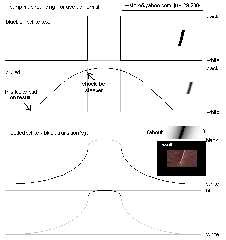 |
 |
|
 |
|
 |
|  |
|  |
|
 |
|
 |
|  |
|  |
|
 |
hi,
i'm trying to make an old book texture
with gold lettering pressed into the leather.
it's all working very nice, i use a black and
white pixel map to switch between the book
texture and a gold texture.
i use a blurred copy of the same image as
a normal for the book texture to make the leather
look like it's pressed in around the gold lettering.
blurring the bump map image does not really give a
good result, what i do now is blur, then copy the
black lettering back on top of it, then blur again,
etc.. (5..10 x) followed by a final blurr with a
small radius.
is there some way to do this inside pov ? (i.e. using
the same black and white image as used for switching
between the 2 textures)
is it possible to get direct acces to the pixel data?
(so i can write my own blurring functions)
thanks in advance,
jaap.
Post a reply to this message
Attachments:
Download 'blured_bump_map.png' (12 KB)
Preview of image 'blured_bump_map.png'

|
 |
|  |
|  |
|
 |
|
 |
|  |
|  |
|
 |
"Jaap" <jws### [at] yahoo com> wrote:
> hi,
got the image in one go, but not the code....:
#declare material_book_red =
material {
texture {
image_pattern { png "bump_neg.png" once } // negative so outside image
defaults to book texture
rotate x*90
scale <-1,1,1>
translate <0.5,0,1>
scale 10
texture_map {
// book texture:
[0 pigment { book_red }
normal {
average
normal_map {
[1, bump_map { png "bump_impressed.png" bump_size 20 } ] //once
[1, crackle 0.6 scale 0.03 ]
}
}
finish { book_finish }
]
// gold lettering:
[1 pigment { book_gold } //P_Gold4
normal {
bump_map { png "bump_letters.png" bump_size 15 } //once
}
//finish { F_MetalE } //F_MetalA
finish { gold_finish }
]
}
}
}
jaap. com> wrote:
> hi,
got the image in one go, but not the code....:
#declare material_book_red =
material {
texture {
image_pattern { png "bump_neg.png" once } // negative so outside image
defaults to book texture
rotate x*90
scale <-1,1,1>
translate <0.5,0,1>
scale 10
texture_map {
// book texture:
[0 pigment { book_red }
normal {
average
normal_map {
[1, bump_map { png "bump_impressed.png" bump_size 20 } ] //once
[1, crackle 0.6 scale 0.03 ]
}
}
finish { book_finish }
]
// gold lettering:
[1 pigment { book_gold } //P_Gold4
normal {
bump_map { png "bump_letters.png" bump_size 15 } //once
}
//finish { F_MetalE } //F_MetalA
finish { gold_finish }
]
}
}
}
jaap.
Post a reply to this message
|
 |
|  |
|  |
|
 |
|
 |
|  |
|  |
|
 |
Jaap wrote:
>
> is there some way to do this inside pov ? (i.e. using
> the same black and white image as used for switching
> between the 2 textures)
> is it possible to get direct acces to the pixel data?
> (so i can write my own blurring functions)
>
Can be done directly, if very slowly in inside POV.
To get direct access to the pixel data of your map, you can use (untested):
#local Pix = function {
pattern {
image_pattern { png "bump.png" }
}
}
image is mapped in function from x=0 y=0 to x=1 y=1, so you would get
pixel <50,100> with
#local Value = Pix ( 50.5/mapwidth , 100.5/mapheight, 0 );
Simpler is to blur the function using another function. A simple blurred
function using the above defined 'Pix' function would look like this:
#local Blurred = function {(Pix(x+.1,y,z) + Pix(x-.1,y,z))/2}
Apply whatever blurring function you like, then add layers, then blur
again, use a sin function, whatever until you get what you want.
When done, render with:
pigment { function { Blurred(x,y,z) } }
or:
normal { function { Blurred(x,y,z) } }
If you've got the patience for that kind of render time, then I would
suggest at least trying the object pattern (with a text object) as a
function instead of using your map. Slower, but the results would likely
be better.
-Shay
Post a reply to this message
|
 |
|  |
|  |
|
 |
|
 |
|  |
|  |
|
 |
Shay <sah### [at] simcoparts com> wrote:
> If you've got the patience for that kind of render time, then I would
> suggest at least trying the object pattern (with a text object) as a
> function instead of using your map. Slower, but the results would likely
> be better.
thanks
i'll try that, it would also give me some more flexebility.
(i now need different bump maps for each book on a bookshelfe...) com> wrote:
> If you've got the patience for that kind of render time, then I would
> suggest at least trying the object pattern (with a text object) as a
> function instead of using your map. Slower, but the results would likely
> be better.
thanks
i'll try that, it would also give me some more flexebility.
(i now need different bump maps for each book on a bookshelfe...)
Post a reply to this message
|
 |
|  |
|  |
|
 |
|
 |
|  |
|  |
|
 |
Thanks for bringing this subject up! I'd overlooked this form of bump map
until now!!!!!!!!!!!!!!!! Way Cool
Post a reply to this message
|
 |
|  |
|  |
|
 |
|
 |
|  |
|
 |




![]()